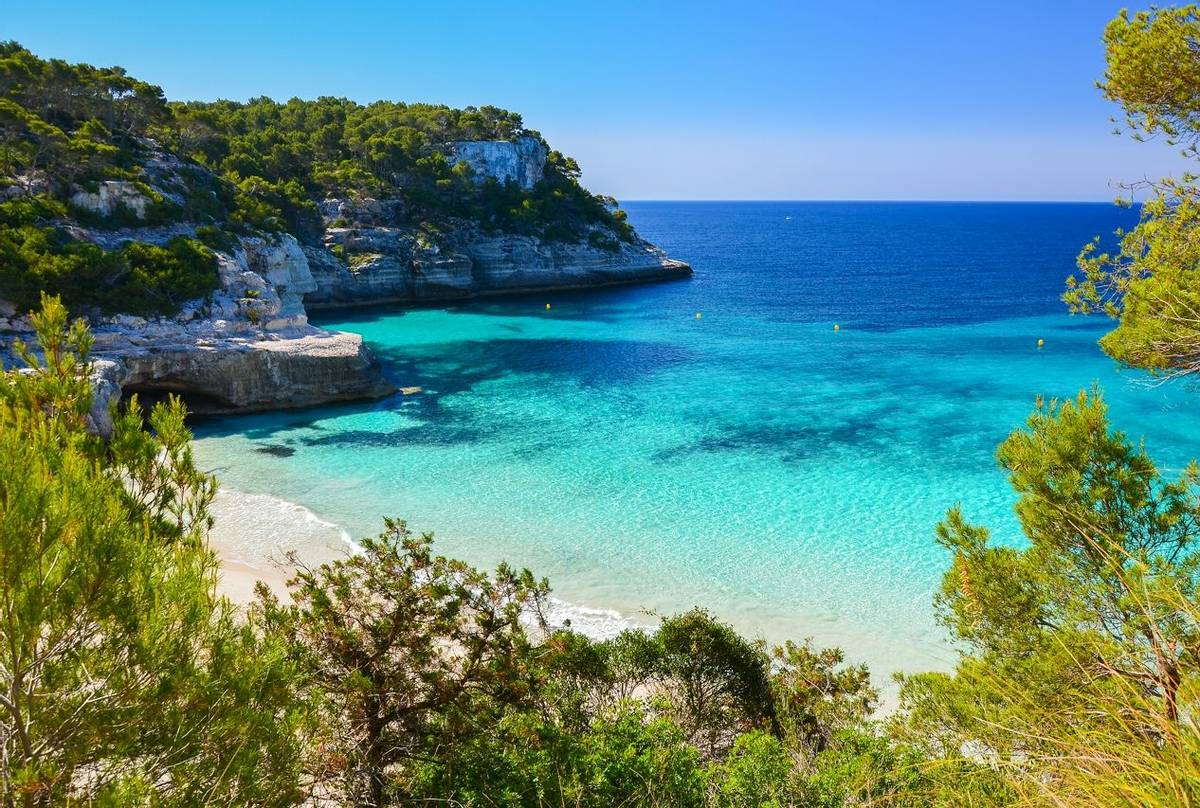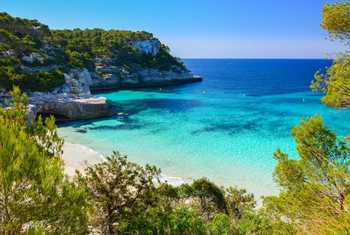I was both surprised and delighted by how much green space there is in Menorca. Developments are regulated, ensuring that plant and bird life can flourish. We saw a multitude of plants and wild flowers and enjoyed a magnificent walk through a gorge, with Egyptian vultures flying overhead. The island is home to many species of birds and also benefits greatly from being on a migration route. Imagine being able to lie in bed and hear hoopoes calling at dawn, then stepping outside to see them crossing the fields. I have found Naturetrek to provide holidays of a consistently high standard. Whether one's interest lies with plants, birds or mammals, there is something to suit all tastes. Their leaders are extremely knowledgeable and keen to share their expertise. The range of holidays offered across all continents is impressive. Naturetrek has enabled me to travel to places that I would not otherwise have been able to visit. The office staff are always helpful and administration is good.
J.H. West Sussex, Apr 24



Tour Itinerary and Reports
- Itinerary
- Tour report - April 2023
- Tour report - April 2022
- Tour report - April 2019
- Tour report - April 2018
- Tour report - April 2017
- Tour report - April 2016
- Tour report - April 2015
- Tour report - April 2014
- Tour report - April 2013
- Tour report - April 2012
- Tour report - April 2011
- Tour report - April 2010
- Tour report - May 2009
- Tour report - May 2008
- Tour report - April 2007
- Tour report - April 2006
Click to see moreClick to see less
Can I help you?
Menorca
Tour Code: ESP04An 8-day holiday of daily excursions in search of the exciting wildlife of this beautiful Mediterranean island.
£1,995
£1,795
Highlights
Tour Itinerary and Reports
- Itinerary
- Tour report - April 2023
- Tour report - April 2022
- Tour report - April 2019
- Tour report - April 2017
- Tour report - April 2018
- Tour report - April 2015
- Tour report - April 2016
- Tour report - April 2013
- Tour report - April 2014
- Tour report - April 2011
- Tour report - April 2012
- Tour report - April 2010
- Tour report - May 2009
- Tour report - May 2008
- Tour report - April 2007
- Tour report - April 2006
Click to see moreClick to see less
Can I help you?
Quick Enquiry
Summary
Menorca (Minorca) is the most easterly and greenest of the Balearic Islands. Its rugged northern coast has a specialised flora and splendid displays of wild flowers in spring, as well as several wetland areas which are important for birds. We will be based for the week in a beautifully restored 18th century Menorcan farmhouse set in 10 hectares of countryside. From here we will explore the island’s stretches of coast, woodland and wetlands by gentle daily walks in search of Menorca’s special birds, flowers and culture.
- Vetches, Cistus, gladioli and Alyssum among the colourful dune flora
- Balearic specialities and Menorcan endemics among a host of wild flowers
- Europe’s only sedentary population of Egyptian Vulture (40 breeding pairs)
- Eleonora’s & Red-footed Falcons
- Purple, Night & Squacco Herons among a wealth of wetland birds
- Moustached Warbler now breeding on the island
- Prehistoric human sites & relics
- The island produces some excellent gin!
- Led by an expert naturalist guide
Grading
Day walks only, all straightforward (and optional). Grade A/B
Not just a smaller version of Mallorca, Menorca is the most easterly, and the greenest of the Balearic Islands. It may not have mountains on a Mallorcan scale, but it is a rugged, very rocky island, has comparatively little flat land, and consequently remains largely uncultivated. The southern coast is a series of low cliffs broken by sandy coves, usually backed with woodland and damp gorges. The northern coast is more rugged, with spectacular headlands and a specialised coastal flora that includes many of the local endemic plants. The island is also blessed with several wetland areas which are of particular importance for birds.
Menorca in spring offers a most intricate mosaic of wild flowers. White and mauve Cistus bushes, yellow Crown Daisies, purple gladioli, plus a great assortment of vetches, hawkweeds, bugloss and Alyssum among the dunes, ensure ubiquitous colour. Asphodels grow almost everywhere, and a wide variety of orchids occur, with Ophrys and Serapias species being most numerous. We should also find some of the Balearic specialities, such as the delightful Cyclamen balearicum, several sea-lavenders (Limonium spp.), and some of Menorca’s endemics, such as the rare Senecio rodriguezii which occurs amongst the interesting and specialised plant communities of the northern coast; the latter are usually lowgrowing, often forming dense, spiny mounds, or are clothed with white or silver hairs to withstand salt-laden winds.
Birds of prey are one of the avian highlights on any natural history tour to this little island. Europe’s only sedentary population of Egyptian Vultures occurs on Menorca (with about 50 breeding pairs), Booted Eagles and Red Kites — though the latter are declining — are seen with pleasing frequency, and a few pairs of Ospreys also breed on Menorca. Other raptors which we may see include Peregrine, Eleonora’s and Red-footed Falcons. One of the most spectacular migrants, which also nests in several colonies on Menorca, is the Bee-eater. At the time of our visit, some of the breeding birds should be arriving and large numbers passing through. Another special bird is Audouin’s Gull, one of the world’s rarest gulls, which wanders the coasts of north-west Africa in winter but returns in spring to breed on the island. There are usually a few around the spectacular port of Mahon (arguably the best natural harbour in the Mediterranean) but sightings can also be expected at several other points on the coast.
The marshes at Son Bou and Tirant, and the fine wetland area of Es Grau support a variety of wetland birds. Little and Cattle Egrets, and Purple Herons are common; Night and Squacco Herons are more elusive but are often present. These areas and the old saltpans at several other sites are also excellent for waders, whilst the island’s woodland and scrub abound with warblers, both resident species such as Cetti’s, Dartford, and Sardinian Warblers, plus the more numerous and active migrants and summer visitors. Stone Curlews, Wrynecks, Hoopoes, Woodchat Shrikes, and abundant singing Nightingales breed on the island and add to the variety.
One of the most exciting aspects of birding in Menorca is the constant possibility of seeing something unexpected. White Storks, the occasional Black Stork, and Gull-billed Terns have all been recorded quite frequently in recent years, whilst Moustached Warblers, which had not been recorded breeding on the island before 1982, may now be seen at more than two breeding sites. Indeed, almost anything can turn up here in spring, and the chance of finding a real rarity, perhaps even a bird previously unrecorded from the island, is very real!
Our accommodation for the week is a splendid, and lovingly restored, 18th century Menorcan farmhouse. Set in 10 hectares of unspoilt countryside, with a large outdoor pool, this is a most relaxed setting. From this delightful base it will be easy to explore many of the most exciting areas of the island, using our minibus to access the best sites which we will then explore on foot. We will enjoy gentle walks along the coasts, through woodland and around the edges of wetlands where we will have plentiful opportunities to see a variety of birds and at least some of the island’s flowers. Another fascinating aspect of this island is the large number of prehistoric human sites — standing stones, towers, stone dwellings, caves and other relics. We will see a number of these during our excursions, as well as gaining a feel for Menorca’s more recent, but nonetheless long and very interesting history. It was, for example, held by the British as a naval base during much of the 18th century, and as a consequence, even today, gin is still produced on the island!
At the time of our visit — before the busy summer period — Menorca has relatively few tourists, and we will be able to explore the island in comparative peace. It is in any case a far less developed holiday island than Mallorca and many other Mediterranean islands. Indeed, most of the coast can only be reached on foot (or by boat) and there are some beautiful, isolated coves and beaches. We should find no difficulty in enjoying the history and, more importantly, the natural history of this delightful island away from the crowds!
Outline Itinerary

What's Included?
- Flights
- Accommodation:
A beautifully restored 18th century Menorcan farmhouse set in 10 hectares of tranquil countryside. All rooms with private facilities.
- Food:
All included in the price.
Reviews
-
-
The itinerary was very good, and the leader well informed and thoughtful.
F.K. London -
The best hotel I have ever stayed at on a tour. Both leaders were first class, kind and considerate and aware of the participants' needs.
M.F. Essex -
Our hotel was excellent and the food some of the best we have had. The welcome and service were great. Our two leaders really know their stuff, but were relaxed and not too serious which was what we wanted. Altogether a nice, relaxing and interesting holiday.
A.M. Gwent -
The Matchani Gran hotel was a good place to stay, and Sean and Jenny did their utmost to make us feel comfortable and enjoy our stay (and the food was first class!). I did appreciate being taken to sites which I would never have got to without guides. A great holiday!
R.L. Midlothian -
The accommodation had excellent personnel with friendly service, calling everyone by name from the start - quite a feat - we even had a birthday dinner which was an unexpected surprise. Menorca is a beautiful place to go - we are delighted to have gone. Where shall we join you next!?
E. McC. Cheshire -
Ted Griffiths and Barry Oxley were superb leaders in every way, being knowledgeable, helpful and fun to be with. We could not fault them in any way.
D.B. Warwickshire -
I found the overall balance of the trip very satisfactory, covering many aspects of natural history.
A.B. Warwickshire -
This was my 6th trip with Naturetrek. I had a lovely relaxing week - it did exactly what it said on the tin! Thank you again!
S.W. Ayrshire -
Both leaders were excellent. The flowers were outstanding and it was very good to see the whole of the island and learn a bit about the differing areas.
A.C. Buckinghamshire -
Lorenzo and his staff were lovely and the hotel was clean and peaceful. The two leaders were extremely knowledgeable and worked well together - all in all, I had a fabulous holiday and learned a lot.
L.C. London -
This was a splendid bird and plant trip, very well led, and with a surprising and delightful variety of both birds and flora.
G.C. Dorset
Dates & Prices
2026

Tour Leader: Martin Beaton
Martin Beaton lives in Sussex and is a botanist, ecologist, landscape architect and landscape painter. He has worked for a range of voluntary and public sector organisations, including the RSPB. Martin led a variety of European tours for Naturetrek during the '80s and '90s, and we are now delighted to welcome him back into our 'tour leader fold'. Before returning to tour leading, Martin held the post of chief executive of the South Downs Conservation Board/Joint Committee and was responsible for the management the South Downs prior to its designation as a National Park. In this post he led national changes to the management and legal status of protected landscapes in the UK. He is now semi-retired, a director of Europarc (the organisation for European Protected Landscapes) and continues his botanical and natural history interests locally in Sussex, on the West Coast of Scotland and also in the rest of in Europe. Since resuming guiding with Naturetrek, Martin has led holidays to Portugal, Mull and Islay, Madeira and Menorca, and we look forward to involving him in many more.
Prefer to Travel in a Private Group?
For any interested natural history club or society, we can arrange for a private departure of this tour.
Enquire
Tour Reports
- Tour report - April 2023
- Tour report - April 2022
- Tour report - April 2019
- Tour report - April 2018
- Tour report - April 2017
- Tour report - April 2016
- Tour report - April 2015
- Tour report - April 2014
- Tour report - April 2013
- Tour report - April 2012
- Tour report - April 2011
- Tour report - April 2010
- Tour report - May 2009
- Tour report - May 2008
- Tour report - April 2007
- Tour report - April 2006
CLICK TO SEE MOREClick to see less
Why Naturetrek?
At Naturetrek we craft expertly-guided group and tailor-made wildlife holidays and cruises to all seven continents. On one of our holidays, you can be assured that our passionate team will enable you to experience and enjoy the best of the world's wildlife and natural spectacles in as comfortable and rewarding a manner as possible, caring as best we can for the environment in the process. We are proud to provide:
- The widest choice of wildlife holidays worldwide
- Tours managed and led by naturalists, for naturalists
- Outstanding value and exceptional customer service
Furthermore, as a Naturetrek client, our office team are always to on hand to help you – so if you have any queries about your holiday, whether before or after you have booked, we will be delighted to answer them on the phone. Please just give our team a call!



 Loading search...
Loading search...























